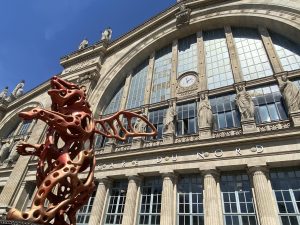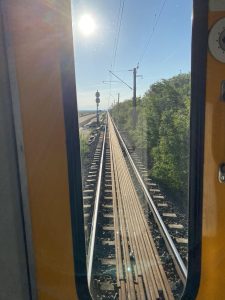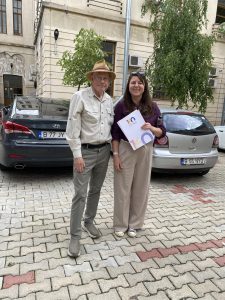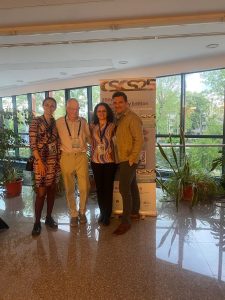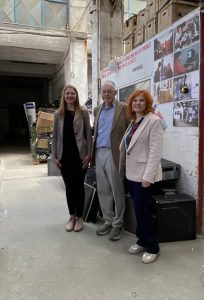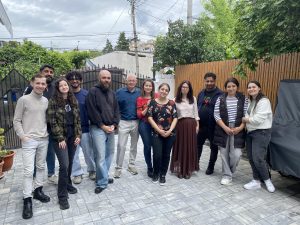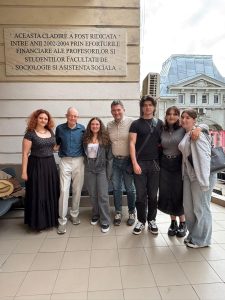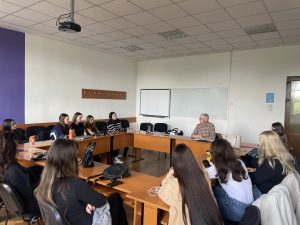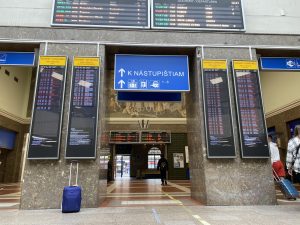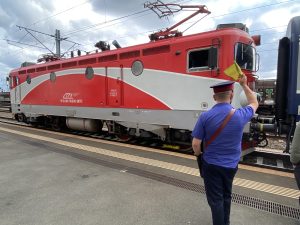The Philosophy of Slow: Tales of a Visiting Professor
By Mike Titterton, Visiting Professor, Faculty of Sociology and Social Work, University of Bucharest
Introduction
Many authors have offered us their thoughts about travelling and writing as they journeyed across Europe. These include the likes of Robert Louis Stevenson, Mary Wollstonecraft, George Orwell and Edith Wharton. Such writers have helped to fire our imaginations, inspiring us to travel, to go and seek adventure crossing the European continent. These writers along with numerous European authors have provided us with rich and fascinating insights into the cultures and landscapes as they journeyed and experienced their adventures in the diverse lands and societies that they traveled through.
For the visitor, even one with experience of two previous visits and with a deep interest in the country like myself, Romania can present something of a puzzle. It is caught in the web of competing geopolitical tensions, uncertain as to which identity to present to the modern world, whether it is in essence Balkan, Carpathian, Dacian, Transylvanian or European. I have worked in other countries in the Balkans, such as Bulgaria, Kosovo and Turkey but Romania has to me seemed a chimera, at times, difficult to grasp, shifting its shape to remain tantalisingly elusive.
When I received the invitation to the University of Bucharest as a Visiting Professor to the Faculty of Sociology and Social Work, it offered a highly tempting opportunity to further explore my chosen research theme of “Risk, Governance and Technology In Democratic and Authoritarian Welfare Polities”. My concerns have to do with the rapid changes going on around us, to do with shifts in patterns of inequality, marginalisation and new technology, along with the impacts on contemporary welfare states. This includes the potential and problems of AI and digitalisation, and the question whether the democratic fabric of these societies is being eroded and marginalised groups further excluded from societal benefits. Romania is notably behind the curve in terms of digital developments and its government has identified this lagging as a priority for policy and for action.
This country seemed to me to be an ideal place to consider such issues, forming a sharp contrast with Sweden and other countries I have been working in of late. I was, moreover, greatly intrigued to find out for myself what I would make of the country and its culture, a decade on from my last visit. In this piece, I describe my experiences of my travels and work in Romania, along with my reflections on these and the issues that arose.
Europe and Romania
Romania sits at the crossroads of geographical and historical Europe. Its incredible history, combining as it does differing layers and levels of culture, politics and geography. This country of 19 million people located in 92,000 square miles where Central, Eastern and South-Eastern Europe meets. This country has been through numerous, dizzying transitions and identities as land of the Iron Guard, Axis member, dictator’s fiefdom, EU member state, supportive neighbour of war-torn Ukraine, through to the resurgence of populism. For me, the fact that Romania is a relatively young political entity, only winning its independence in 1877, and nominally democratic since the 1990s is seminal in explaining its current existential unease.
My reading, prior to my visit, consisted of Misha Glenny’s magisterial history of geopolitics in the Balkans, Robert Kaplan’s thoughtful account of the modern political history of Romania, along with travel writing by the likes of Patrick Leigh Fermor, Nicholas Crane and William Blacker. I find such authors interesting as I have in the past , under a nom de plume, attempted travel writing in relation to countries such as Spain and Turkey. These writers provide sketches of a world already changed and yet apparently now changing at an increased pace. They are all “foreigners” seeking to get a handle on some aspect of the country’s culture, geography and history. Though they often refer to the country as was, in some important ways things have not changed significantly. I believe that an understanding of any country is incomplete without some glimpse of its past.
In February of this year I was fortunate enough to experience a Visiting Scholar visit to the University of Gothenburg, to the Quality of Government Unit. I was struck by a number of things on this visit. One was cluster of concerns expressed by younger people, including postgraduate students and postdoctoral researchers, but also others outside the world of the university of the mediated effects of globalisation, the continuing spread of English, the heightening of anxieties and uncertainties over geopolitical affairs and the brave new world of rapid technological change in Europe. All this provided “grist to the mill” of my guiding research theme of risk, governance and technology in relation to democratic and authoritarian contexts.
However, it was now time to think about the journey awaiting me in making my way to the Balkans. As I gave thought to my pending travels, it dawned on me which mode of transport would be the most appropriate. What better than to travel by that time-honoured mode of transport, the railways? To travel by train across Europe: the very thought began to stir my imagination.
Since one element of my considerations is the changing pace of contemporary life and the impact of technology on our lives along with its potential for inclusion, it seemed highly appropriate to travel by this mode. I decided to try to be less reliant on digital technology and to only travel by public forms of transport; there would be no taxis if I could avoid it. There would be, therefore, no digitised requests to Uber or Bolt to come and rescue some unknown corner of whatever place I found myself in. It would have to be on foot if need be, especially if no public transport option was available. Robert Louis Stevenson, who traveled on a donkey, would have approved.
Then I unfolded my map of Europe to look at what was involved in such a journey, from the north-east of Scotland to the south-west of Romania and the capital city.
Journey To Bucharest
North-East Fife to London
Early one sunny morning, I set off from my house and left a small town called Cupar in North-East Fife in Springtime. I sat down on the train and could not resist admiring the fine morning mist clearing from the fields and the hills. The sun gleaming off the seas of the Fife coastline, crossing the famous Victorian Rail Bridge over the Forth and into Edinburgh, rolling in beneath the Castle to Waverley Station. Grabbing a coffee near the platform, I was able to catch the southbound train to London.
I had taken with me three novels for the journey: Emile Zola’s A Love Story (published in 1878), Sabahattin Ali’s Madonna In A Fur Coat (1943) and Anthony Powell’s A Dance To The Music Of Time (volume two, 1952). There is, I find, something of a sense of satisfaction after making progress through any literature of quality. I had learned from previous journeys of the mistake of bringing large, densely written novels to try to read, a difficult enough task at the best of times, let alone when the work was also demanding and one’s eyes were closing on simply lifting the book off the side table beside one’s bed at the end of a busy day. It is quite a balancing act choosing a book that can hold your attention and fit neatly into your backpack or suitcase.
The train offered views of the eastern coastline, with the North Sea alongside and rocky inlets of the cliffs below, before traversing the flat plains leading to London’s King Cross; I strolled out of the station into the late afternoon sunshine amid the crowds to admire the Victorian St Pancras nearby. I crossed the busy square to catch the Underground train to Pimlico, where my accommodation for the evening was situated. This magnificent quarter has, like the rest of London, been a village absorbed into the city and has distinctive architecture, pubs and old churches.
I set off from Pimlico Tube Station early the next morning and fetched up at St Pancras, and downing a coffee and croissant, boarded the Eurostar to Paris.
London to Strasbourg
The smooth ride of the Eurostar trains makes for a great travel experience. I was soon zipping through the southern English and northern French countryside, arriving on time at Paris Gare de Nord. Spilling out of this historic and grand station into glorious weather, surprisingly warm, I walked over to Gare de l’Est, past an all too tempting, archetypal French cafe en route. Reaching the station and glancing up at the board in the station I noticed a departure about to set off for Strasbourg. Hold that train!
I managed to find a seat as the train chugged forward on its cross-country journey southeastward revealed a verdant, flatter countryside as we rolled smoothly to its destination. Arriving in Strasbourg, with the descending sun shining through the modern design of the station, I was soon wandering around in the older, more historic centre. After dutifully trailing around various hotels with my famous wheelie suitcase I ended up back at the very first hotel I passed after leaving the station. The hotel I found was situated not far from the station Strasbourg is a delightful historic city with a wide canal and a magnificent Cathedral displaying Gothic and Baroque influences. The old square was however packed with tourists and not easy to negotiate a way through the crowds, a far cry from the days when the Cathedral was simply an awe inspiring place to worship, rather than one more stop on the tourist merry-go-round.
“Over-tourism” tends to be the norm now in popular European cities, from Edinburgh to Venice, from Barcelona to Florence, with deleterious effects on local communities and accommodation. To take just one example, Barcelona saw a staggering increase of 185% in the number of overnight visitors in the period from 2005 to 2019. Tourism in Bucharest itself has grown substantially, rising to nearly 2 million visitors now. It is surprising, nonetheless, to note the rapid growth of tourism earlier in the year than previously would have been the case. The drivers of this pressure piled on to fragile European cities include several factors but notably they do include globalisation and digitalisation. There are, however, numerous places in such cities where it is possible to escape “far from the madding crowd”.
Austria or There and Back Again
From Strasbourg I traveled into Austria and on to Salzburg, on a delightfully sunny evening. This was a glorious sight, with its fairytale-like architecture, the castle on the hill, the pleasing curve of the river. There was no shortage of tourists, with a local holiday adding to the crowds. It proved an unexpected challenge finding a suitable hotel that was less than eyewateringly expensive to stay a night. However, the town proved highly pleasing to the (watering) eye by night as well as by day.
The next morning I was back at the railway station, with a ticket for Vienna firmly in my possession. I boarded a long, dark red train waiting at the platform, with anticipation at the journey ahead and took my seat. I was absorbed in my writing and reading and glancing up, was rather surprised to look up to see pleasant, yellow-flowered meadows, tiny wooden churches on hill sides and a procession of increasingly high mountain ridges. I had to admit to myself that I did not recall seeing mountains around Vienna. Indeed had it been so, it would not have been famously besieged by Ottoman forces, finally in 1683 marking the end of expansion of this empire.
However it was not Vienna, with its grandiose Habsburg Empire buildings, but a place that lay in the opposite direction from where I was meant to be heading – namely, the Alpine centre of Innsbruck. What a blockhead (as they say where I’m from)! Overconfident in my rusty German and alas being far from mindful, lost in thought, I had unintentionally ended up among the Tyrolese Alps, far from the Viennese plains of the Danube river basin. Nonetheless, it provided a chance to visit another historic town and to take stock of my journey and my work.
A further shock lay in store for me as I stepped out the station and rather than being intoxicated by the glorious scents of sweet Alpine mountain air, I was instead confronted by the quasi-brutalist, industrial, smoggy quarter surrounding the streets out front, where diesel-fuelled buses sat idling their engines. Dominating this architectural jumble was a huge, black Borg-like cube, which turned out to be a hotel. Resistance is futile! I hastened past this modernist eyesore towards the older part of the town, where thankfully the air quality improved, the noise subsided and the architecture on display proved far more enticing, picturesque even, nestled within a dramatic semi-circle of mountains. There was much to admire about the old town of Innsbruck, with some snow patches still visible on the tops overlooking the buildings far below. Rather less admirable was another indecently pricey but conveniently located hotel room. This unlooked for expense at least allowed for an evening exploring the old town, plus a comfortable night’s rest and a decent breakfast to set me up for my onward journey.
Bratislava and Budapest
Following a discussion with the friendly hotel receptionists and the helpful railway station staff about my options, I decided to travel all the way from Innsbruck to Bratislava. Cruelly this involved returning via Salzburg but the views made it rewarding. On arrival at Vienna station, I just managed to catch a train that was sitting there and was soon rattling into a new country, namely Slovakia. I was a little nonplussed to find myself arriving not in the centre of Bratislava but in some western station and had to take a bus, after an unintentional detour, to the central station, in order to walk into the old town.
I warmed to old Bratislava at once when I eventually found it, tucked as it is down beside the river. Even under overcast skies the historic architecture appealed to me greatly, as did the relative lack of tourist groups that plague other cities in Europe. I chose to stay in the heart of the old town at a refurbished small hotel, which proved a good choice, with it being very handy for restaurants and for walking around. Following a traditional Slovakian dinner, I had time to wander around to view the old town during the evening darkness.
In the morning it was a stiff walk with suitcase to the train station. From the Slovakian capital it was an slow train down to the Hungarian capital, Budapest, accompanying the River Danube. It was stimulating to see Budapest again and from such different angles than my previous visit. However the weather had really deteriorated and I was taken aback by the chilly rain pelting down. It was clearly time to hit the subway. When I did emerge from the Metro, the faded grandeur I associate with Budapest was on display, still visible in that weather. I made my way towards the old Jewish Quarter and the time-honoured Grand Synagogue, finding a reasonably priced hotel nearby. The rain eased enough for me to make a foray to a traditional and popular restaurant, with a beer and country farm dish, cheery atmosphere lightening the mood of the damp evening.
From there, after negotiating the Metro the next day, I caught a train from Budapest Nord to Timisoara, which seemed a reasonable destination, with its association with dramatic events in recent history. The train rumbled slowly down along the Danube as the landscape slowly changed, with red tiled roofs and small houses on show. The train made numerous, if unpronounceable, stops such as Békéscsaba and finally I crossed the frontier into Romania.
Romania and Bucharest
Border to Bucharest
Crossing the border by train from Hungary provides a gentle introduction in sharp contrast to flying from abroad into Bucharest OTP aeroport. The landscape imperceptibly changes and the only noticeable transition is the transfer of the engine close to the border, as the local operator CFR Calatori, is responsible for train journeys in Romania. Eventually the train reached Arad, where after a discussion with a local person on the train, I alighted rather than Timisoara. I decided to stop and catch the night sleeper train south to the capital. Arad, with an aged steam engine outside its rather splendid station, was my chance to stand again on Romanian soil, or rather concrete in the way of the modern world.
The sleeper train was already sitting by the platform when I re-entered the station and it turned out to be a pleasurable and interesting experience, all the more so for being so unexpected. This was both a surprise and something of a treat for the weary traveller. Watching the northern Romanian countryside slip by, under occasional flashes of lightening highlighting the Habsburg influenced styling of churches and buildings was unforgettable. I eventually read my Zola novel and drifted off into a fitful sleep as the names of towns tumbled past the window.
Arriving in Bucharest
In many ways Bucharest appears to have to have changed considerably, especially since the late 1990s. I scarcely recognised the city that I first visited in 1999. Arriving by train early in the morning, Gara de Nord Station provides something of a deceptive impression to the visitor, with its aged neoclassical building. Making my way down into the nearby Metro and negotiating the subway system was the first hurdle to surmount. Fortunately friendly local people proved of invaluable assistance to me, as indeed turned out to be the case for the whole of my stay in Romania.
I had decided to spend at least the first night in the one area I was somewhat familiar with from my previous visit, namely the Old Town, the Vecchio Centro, consisting of the historical Lipscani quarter. This was to prove the first of numerous culture shocks on visiting Bucharest some ten years on from my last visit. I emerged blinking into the harsh daylight of Piata Uniri, the central square of the city, to be met by almost overpowering sights, the bustle of crowds and above all, noise. The contrast with what I had experienced before was verging on traumatic. In the midst of this mayhem I spent my first – and last – night in the Centro Vecchio, the old town, which turned out to be Party Central. My little hotel was caught in the middle of a war between a Greek cafe and a Turkish restaurant, with the latter defiantly drowning out “Zorba the Greek” by pumping out Rod Stewart’s “Do Ya Think I’m Sexy?” at deafening volume at 1 am in the morning. No, Rod, I can’t say that I do. Globalisation has a lot to answer for.
Nursing a coffee the next morning, I listened to the Greek hostess’s lively tales of being a foreigner among the Romanian people. She then confided to me that she had something of a crush on Vlad the Impaler, whose palace lay around the corner, ignored by tourists and locals alike. Intrigued, I went to have a look, peering through a broken fence. There it was, now the haunt of cats and their kittens, play fighting and chasing one another among the overgrown weeds. This historic relic of a palace has survived somehow, amid all the momentous changes and modern day uproar. As I made my way via the Metro to my first meeting at the University, I couldn’t help wondering what other incongruous finds I would come across during my stay.
Bucharest Days
As the days unfolded I was to discover several transformations had occurred in Romania, some of which were more obvious than others. That so much had changed since those earlier visits, the cars, the bright lights, the globalised brands. It was the same rather discombobulating sensation I experienced when I returned to working in St Petersburg in the winter of 2023, some 20 years after my first visit. The globalised city look could be anywhere, with Starbucks, the KFCs, Burger Kings, fast food outlets galore, similar to shops and retail outlets that can found anywhere. The presence of so much fast food is not a good sign of progress towards a healthy city and a health-conscious population.
There are surprisingly numerous green spaces in the city, such as Izvor Park, and there is much potential for developing environmentally-friendly approaches to development. But Bucharest is presently some distance away from being a healthy city. Cars rule this city and are accorded priority over pedestrians in the city; crazy drivers predominate! The car currently is very much the king with few pedestrian zones on offer. At times it was slow progress indeed walking across the town, with much time spent waiting for the green light to walk across a street. The deadly traffic takes some getting used to. On my very first day I came close to spending my last moments on earth outside the very door of the Faculty as I crossed from Cismigiu Park, when some psychopathic driver shot round the corner at 70 mph. From that day on I was careful when crossing roads, with local pedestrians accompanying me where this was possible.
Thanks to the warm and welcoming efforts of Diana-Alexandra Dumitrescu of the Administration and of the Faculty staff and students, led by Cosima Rughinis and Robert Similea, I quickly settled into life at the Faculty and wider university. I was very well treated by both staff and students from the day of my arrival onwards and during my entire time spent at the Faculty and Administration offices too. Everyone was friendly and it was a privilege to be able to spend time with them. My colleagues were most hospitable and despite their busy schedules, some were able to spend time over coffee or in the office with me, discussing research and teaching topics of mutual interest. The students were keen to talk about their interests and their projects as well and I found it instructive to listen to their enthusiasms and their concerns about current issues.
I was fortunate that my office had superlative views of the tall trees of Cismigiu Park and distant buildings of the district, pyramid shapes above a sea of turbulent green, as trees waved in the face of contrasting weather fronts. I was pleased to discover that I could write there, other than doing one’s administrative duties. When I really needed a shift to stimulate thinking and writing, there were pleasant cafes nearby. The park offered many a pleasant spot for reflection and relaxation. The Rotunda garden, with its characterful busts of famous Romanian writers, provided a particularly appropriate space to visit for a quiet moment or two. Such spaces provided a bit of tranquillity amid the busy days of teaching and researching at the Faculty.
I have worked in some interesting offices in Edinburgh in the past, both as a student and employee, which I found myself using rooms used by the likes of Arthur Conan Doyle, Tobias Smollett and Erving Goffman. This includes spaces used by my great social policy hero, Richard Titmuss, who worked in Edinburgh advising the innovative Scottish Office. However, to top these, on a previous visit to Bucharest I found myself in a meeting with the Ministry staff in a magnificently Baroque room, in which the wonderful composer and pianist Franz Liszt had played. In the university room I now sat in, however, it was easy to be inspired by the view and if an additional boost was needed, the cafes nearby provided take-out coffees and tasty snacks, such as prajitura.
Numerous meetings and stimulating discussions took place with the students and colleagues around the campus, both within the Faculty campus and the local cafes nearby. One valuable outcome of these discussions has been the setting up of a project, led by the students and supported by my advice, to look at student health behaviours and the prospects for establishing a healthy university (https://unibuc.ro/studentii-universitatii-din-bucuresti-invitati-sa-participe-la-un-studiu-despre-obiceiurile-legate-de-sanatate-in-randul-studentilor/).
Visits to Local Organisations
What was very striking was the sheer, vivid contrast between the city centre and the districts beyond the centre. I was intrigued by a tram ride I took one day to the district of Rahova, in order to visit a Roma NGO, Agentia Impreuna. As I sat on the tram, trying to digest the transition from the centre to the outlying districts, my growing impression was,“here’s the Romania I remember!” Here it was, in all its rush of intense images: apartments, poorer citizens, older people, the smell of great bakeries and fresh fruit, with a local market lining the whole of the street. There was very little English spoken but people kindly tried to help me as best they could on the tram and the street.
Of the 10 – 12 million Roma who live in Europe, roughly 2.5 million can be found in Romania, forming the largest ethnic minority of the population of the country. Estimates vary but the risk of poverty is approximately three times higher for the Roma, compared to the rest of the population. Agentia Impreuna (https://www.agentiaimpreuna.ro/) is an impressive independent organisation, well funded and well used apparently by its beneficiaries. It runs accredited courses and provides an inter-ethnic community centre. The latter include young Roma, helping to ensure that they are receiving some measure of educational input to help them make choices for their future and overcome some of the early forms of disadvantage, including labour market access biases.
Youth unemployment is comparatively high in Romania, with estimates of one in four young people being unemployed. Among young Roma, these estimates are difficult to make, due to the lack of publicly accessible data of the breakdown of youth unemployed for the Roma population. We can reasonably infer that the rate is likely to be considerably higher (with the proviso that without hard data, this remains speculative). The difficulties in efforts to boost labour market access for both Roma and non-Roma form the topic of a paper I have recently submitted, along with two Romanian colleagues, to an academic journal; this takes up and develops the notions of US sociologist Robert Merton regarding forms of disadvantage that are cumulative in their effects.
Another study visit I made in the company of Romanian colleague, Silvana Crivoi, was to see a social enterprise called Ateriere Fara Frontieres (https://atelierefarafrontiere.ro/), which is a registered NGO that provides the recycling of electronic and other goods. The enthusiastic director, Cristina Biciila, explained that as one of its activities the organisation fixes up and recycles electronic equipment such as laptops and they give these to rural schools. Recycling of material to make aprons and bags takes place, involving the employment of women. The organisation also has an organic farm somewhere out the outskirts of the city. It is a great example to consider for various reasons such as its environmental impact. But for me, such initiatives provide an excellent illustration of inclusion in labour markets, employment and skills development. Vulnerable and excluded people can feel they have a contribution to make to their economy and their society.
Ateriere Fara Frontieres has developed digital training programmes for their beneficiaries precisely to reduce this gap and facilitate access to the labour market. Thanks to its programme, “Click on Romania”, through which it donates annually 4000 computers to schools in disadvantaged areas. The organisation also wishes to contribute to support digitalisation in younger age groups.
Mental health is another issue of concern across Europe and Romania is no exception to this. While precise and updated information on national prevalence remains limited, various sources suggest that around 10% to 15% of the Romanian population have experienced mental disorders, with about 1 in 10 young people having a diagnosed disorder. I was therefore keen to visit a mental health NGO, which a colleague and I visited on my first visit to Romania, the Romanian League for Mental Health (https://mentalhealthforromania.org). It was very interesting to catch up and hear about the progress made in terms of mental health legislation, awareness and services. However, it is also very clear that substantial gaps remain and obstacles exist to the development of a satisfactory community-based mental health service in Romania. Nonetheless, it was pleasing to hear about the positive developments made since that highly memorable visit in the autumn of 1999. The growth of greater awareness is notable as is the reduction of discrimination and prejudice in Romanian society. This is broadly in line with other European countries, though there remains much to achieve and funding is scarce.
Politics Matters
The unfolding excitement of the presidential election during my stay proved an instructive experience for a visitor to Romania. The election of 2024, which the rightist populist candidate Calin Georgescu, had won, had been annulled for alleged interference by foreign (mainly Russian) bodies. Round Two of the election took place one Sunday, with relatively peaceful rallies, as far as I could tell as I walked around the city, observing what was happening. Liberal Bucharest mayor Nicusor Dan won, beating rightist populist George Simion, 54% – 46%. Every Romanian person I spoke to that day said that they had voted and had done so as a matter of civic duty.
Whether a Macron-like technocrat like Dan can actually live up to promises made during his campaign and deliver “fundamental change” and institutional reform remains very much a moot point. Underlying social, economic and political tensions remain deep seated within the countries of Central Europe and the Balkans. Romania is no exception to this and a rethink about how such things are done is required.
Culture and Conferences
A vivid impression formed in my mind of a highly literate and engaged citizenry in Bucharest, reinforced by my visit to several bookshops in the city. These included Libraire Humanitaire, which has a branch on Bulevardul Regina Elisabeta and the splendid, Borges-like labyrinth of the Carturesti Carusel in the Old Town, refurbished in 2015 from an old bank As well as offering books, CDs, vinyls and cards, the lovely cafe at the top offers a chance to work and to talk to customers. One conversation with a high school student in this incredible bookstore stands out in my memory. We had an in-depth talk about her life, her use of digital technology, her comments on her expectations and the elections. She revealed an impressive grasp of English in contrast to my basic Romanian.
I was delighted to receive an invitation to attend the stimulating Cosmobeauty Expo-Gala 2025 (cosmobeauty.ro) that took place in Bucharest. I have had a longstanding interest in notions of beauty, wellbeing and body image among young people and among vulnerable groups. For example, the prevalence of eating disorders such as bulimia nervosa, binge-eating disorder and anorexia appears to have been rising in Eastern Europe since the 1990s. The connecting links between health behaviours, self-valuation, emotional and mental wellbeing, resilience and disorders among young people and vulnerable groups provide one way, for me at least, to understand and address these behaviours and pathologies. We need to be better informed and a lot smarter in the way we tackle them and prevent them from developing in the first place.
I also attended an excellent CSCS25 conference in Bucharest on Artificial Intelligence (https://25.cscs-conference.com/) as a co-contributor with Romanian colleague, Robert Similea, with the theme being the potential for AI developments in Central Europe and its problems. One key finding of the paper was the nature of the digital divide within Romania and what we might call the “knowledge divide”; for example, it was found that young and better educated groups knew more and were more aware regarding AI and its potential. A shared concern appeared to be the impact of the new technology upon the young people and students in diverse settings. A special EuroBarometer on the “Digital Decade 2024” found that Romanians were according increasing importance to digitalisation for connecting with family and friends and for accessing public services. However most reports and most of those I spoke to recognise the need to improve education about and skills in using AI and digital technology more generally. The EU’s Digital Economy and Society Index shows Romania and Bulgaria at the bottom of the current ranking of EU member states, a sharp reminder of the distance Romania still has to make up before it catches up with the rest of Europe.
An end-of-conference dinner was offered and this proved a useful occasion to relax in pleasant surroundings and to meet some interesting senior academics from Romania and countries like Poland, even practising some language skills. Occasions like these help to forge contacts and working relationships across the country and between countries too.
There were many random encounters while out and about in Cismigiu Park, the museums and art galleries, in the Metro and cafes too. The National History Museum of Romania with its magnificent collection of historical treasures and archaeological finds, such as the casts from Trajan’s Column, especially those relating to the Dacian-Roman wars. I visited it one morning with a Romanian colleague and the two of us stood in wonder, trying to absorb the extraordinary sight that met our eyes. As a symbolic representation of public relations, political power and military prowess of the Roman Empire, the column surely takes some beating.
Equally astonishing is the vast collection of artworks in the National Museum of Art of Romania; while there are European and Oriental artists on display, it was the Romanian artists and their depictions of life and their country that were particularly fascinating to me. A cornucopia of intriguing artworks to be relished can be found. Under the modern Romanian art banner, works by Aman, Pallady, Luchian, Grigorescu and Brancusi caught the eye, among many other artists. I was also keen to visit Theodor Pallady’s superb house museum near the Athenaeum. This Romanian artist straddled the end of the 19th century and the first half of the 20th century and his remarkable body of work can be seen both in the historic house in Spatarului Street and in the National Museum of Art.
The architecture of Bucharest itself provided an endlessly fascinating spectacle, with its juxtapositions of old and new, traditional and modern, historic Habsburgesque stylings and beastly brutalism jostling side by side, along with the grandiose schemes of Ceausescu. However, the old centre somehow survives, ruined by tourism and party town as restaurants and cafes compete through ever louder sound systems. Where the Faculty is located is in May ways quite delightful quarter, with the dominant architectural styling being Baroque meets Art Deco. The surprisingly large expanse of Cismigiu Park provides a valuable, family-oriented and essential green space in the heart of this historic district. Rammed with children’s play facilities and cafes, this green space is a genuine environmental treasure in a busy, noisy and car-infested city. What is a more mixed blessing for the city, however, is its accommodation for visitors, hotels, AirBnB and the like. It’s often a matter of potluck whether you end up in accommodation that turned out to be surprisingly splendid or an unexpectedly challenging, and whether it is respectable or a complete scam. I experienced both ends of the spectrum. Nonetheless, the hosts and staff were for the most part friendly and helpful. For the second half of my stay I was offered a place in the University’s hostel, not far from the Military Academy and a short Metro or bus ride from the Faculty.
Pitesti Interlude
I was very fortunate to be presented with an opportunity to visit another interesting place outside the city, spending a weekend as the guest of a very engaging and deeply impressive businesswoman, Roxana Calota, and her family in Pitesti, a historic town about two hours north-west of the capital. I had previously met Roxana and her daughter at the Cosmobeauty Expo-Gala 2025 in Bucharest and their energy and commitment to consider the sort of social issues I had raised over coffee at the conference had had a big impact on me.
One Friday after work I travelled to Pitesti by train, sharing a compartment with voluble workmen and sitting beside a friendly woman, whose English improved noticeably the more she conversed with me. In Pitesti itself I was made welcome and very hospitably treated; I was met off the train by the friendly family of my host and taken to the hotel where I was staying. I was surprised by the unexpected outbreak of a huge thunderstorm, with dramatic lightening flashes and torrential rain. Fortunately this sudden storm had cleared by the morning.
I learned about the incredible mix of history and culture of the town and region, with its splendid art gallery with works by great local artists such as Sorin Ilfoveanu, as well the dreadful and tragic story of the prison museum. We made a fascinating visit to the magnificent Villa Florica, the Bratianu residence where prime minister Ion C. Bratianu (1821-91), one of the founders of the National Liberal Party, lived with his family; his brothers and sons eventually ended up in prison, symbolising the tragic circumstances and consequences of revolutionary change. The mixing and intertwining of personal and political histories proved most moving and I was sorry to leave the town and the delightful, friendly and hospitable people I was privileged to meet there.
The Journey from Bucharest back to Fife
My stay in Romania eventually came to its end for the time being and I had to start thinking about my return journey. The travels back to Scotland was to prove as equally adventurous as the outward journey and allowed me to select a routing substantially different from earlier. I decided to take train journeys once more from Romania to Scotland and so I set off from Gara de Nord on Saturday evening on the sleeper train I arrived on. As I waited I talked to a woman about her life in Romania and her concerns about the courts overusing the result of the election back in the Spring.
The couchette train left the station that evening, sliding out elegantly and at a pace allowing time to bid farewell to my colleagues and friends in Bucharest and Pitesti in my mind. I was soon relaxing in my little cabin. This time my sleeping was much improved. However for the next day or two I occasionally found myself rocking internally in a train-like manner, as I waited in Arad for my connection to Budapest. I met another traveller with whom I compared notes about travelling in different cultures, comparing notes in a fashion that morphed into experiences of life and assumptions and expectations, how these have changed markedly over time. Budapest was baking in summer weather and despite the heat, it was very pleasant sitting drinking home made lemonade at an outdoor table admiring the late evening light playing on the aged Hapsburg era buildings.
In the morning I caught a train from Budapest Keleti and decided to next travel all the way across Austria to Regensburg in Germany. The journey through Austria yielded glorious scenery, particularly in the northern stretch, in splendid weather. Small churches could be glimpsed amid lush greenery, reflecting a countryside delicately balanced between development and nature.
As we approached the German border the weather turned, with large dark clouds looming, threatening rain. Nonetheless, I was delighted to be back in Germany, with a sense that it seemed deeply familiar in culture, geography and people. Regensburg itself is a magnificent place to stop as its wonderful Gothic and medieval architecture is on display everywhere, not least its striking Cathedral with its spires reaching high into the sky. The overcast pall added a certain mystery, suitably Gothic in adding a medieval ambiance.
Following a delightful stay in a quaint little hotel in the Old Centre, in late morning I caught a train through to Aachen, near the border with Belgium. There is, moreover, a magnificent ancient Cathedral as well as the tomb of Charlemagne. I grew quickly to like Aachen despite a semi-comical if frustrating hunt for my accommodation, which eventually proved to be not far from an old church, with a terrific little restaurant nearby.
The next day was quite incredible, in terms of travelling for its own sake. I managed to leave Aachen in the morning and after crossing four countries, ended up in London that evening. This astonishing day of travel had numerous highlights to choose from. Travelling through Belgium and its capital, Bruxelles, changing trains at Le Mouscron, at last arriving on gloriously sunny afternoon in Lille. It felt wonderful to be back in this splendidly French city in the north. I had time for a delicious meal in La Grand Place. It was tempting to stay there into the evening, relaxing with another cold beer, to wander round the old streets with the sun slowly sinking.
However, it was growing time to catch the Eurostar train from Lille Europe station. This is a well designed station, which was organised and not as chaotic and busy as Paris or London stations can be. This smooth journey was pleasant and convenient and surprisingly quick, whizzing through Northern France and the train was soon popping up in Southern England.
Before I knew it, the train was soon slowing down, arriving at St Pancras. This time London King’s Cross area looked darker and busier and I was relieved to have found accommodation nearby, which was very basic but convenient location. In the evening I checked out departures for Edinburgh in the morning, finding the large lunch in Lille still sustaining me. King’s Cross has improved markedly of late and it was amusing to spot Harry Potter’s Platform 9 and 3/4, which has been granted a place in the station. However, despite its new roof and interior, the rebuilt station hall is still large, cold and rather forbidding, and given the cluster of rootless people who hang round stations, really requires a reconsideration and redesigning to make it more welcoming, more people friendly and less of a vast, empty auditorium.
The next morning I was able to board the 9 o’clock train for Edinburgh, glad I had bought a sandwich and water the previous evening and was able to relax with a coffee in my seat, watching the English countryside slide away and head into the North, through York and finally crossing the River Tweed at Berwick and entering Scotland, with the enjoyable east coastline to admire, with its steep cliffs and tiny, rocky inlets. I was pleased to finish the last of the three novels I had taken with me as the train finally rolled into Edinburgh, along with making further progress with one or two papers I had begun writing earlier.
After spending an afternoon in the centre of the Scottish capital and its splendid National Gallery of Art, I managed to catch the final train of the journey, namely the Fife coastal train back to my house in the evening, finally arriving home after what certainly felt like another epic journey across Europe.
Reflections on the Experience: Issues To Think About
The entire experience of working in Romania along with my travels there and back from Scotland has proved such a rewarding and deeply rewarding experience. In many ways I am still reflecting on it and I am anticipating my return there soon.
The diverse character of the ever-changing landscape of Northern Europe and Central Europe is quite remarkable, as are the subtle shifts as one journeys on a train as opposed to an aeroplane, as also are the different climates and weather systems one encounters on such a journey. The train journeys across Europe and back again provided an incredible experience at both a personal and professional level. Personally speaking, this journey gave me so much food for thought. Hence my perceived need to try to slow it down through the mechanism of my slow travels across Europe. I certainly learned a great deal from my travels and from my experiences in Bucharest itself.
I was very fortunate to meet with such interesting and varied people across Europe and in Romania itself, who generously gave of their time to talk with me, as well as the chance to visit such intriguing and thought-provoking places and projects in Bucharest and Pitesti.
Conversations arose naturally in the course of my train travels and my stays. The different people that I spoke to were happy to talk about books and films they liked and soon warmed to talking about the principal issues affecting their lives. These included topical talking points such as lively points concerning four main sets of headings. These were contemporary politics, digital technology, Europe’s railways and commemoration of historic events, and how these issues had an impact upon them.
Politics and Places
Some of the people I spoke to included particular angle e.g. impact on their work or where they live or the wide issues facing North America and Europe. The common features that we all face across Europe provided a sense of shared solidarity and a sense that “we Europeans are all in this thing together”. We, that is, except for the governing elites who have largely failed to safeguard the health, well-being and security of their local communities, judging from the comments made and other evidence.
In terms of the cluster of points to do with political issues, these are the concerns that arose in numerous conversations with the fellow travellers and workers I talked with. It was all too evident that there was clear expressions of discontent with the liberal elites governing Europe and their countries; they drew attention to concern about the rise of polarised political opinions and extremisms, of left and right; the failures of political parties, in terms of listening. This was matched by a feeling of abandonment by governments during the the Great Financial Crisis of 2007-2008 and the pandemic lockdowns of 2020-2021; this was accompanied by expressed concerns about corruption, especially in Central Europe and distant elites in European capitals. As an issue, corruption in Europe is a complex one, with perception and reality sometimes at odds. This message was reinforced both by my earlier visit to Gothenburg’s Quality of Government Unit and by my attending Dumitru Sandu’s interesting seminar on data and its interpretation at the Faculty. Nonetheless, dissatisfaction with these elites is helping to drive the sharp loss of confidence in democratic politics and notable growth of interest in authoritarian and populist movements.
Railways and Resources
Consensus on the lack of adequate investment in European railways was very apparent, all the way from the north-east tip of Scotland down to south-west corner of Romania. Some of those I conversed with drew critical attention to the state of the railways themselves, complaining about the lack of public investment and associated decline, chastising governments and state enterprises for neglecting their responsibilities to the public and to long suffering rail users. Germany surprisingly provided ready examples of late running trains, borne with a weary resignation by its local citizens, placing the blame squarely on the failure to invest in railway infrastructure by recent German governments.
In Central Europe, particularly in Romania, everyone mentioned the slowness of any journey by train in the country and highlighted the lack of funding of the railroad infrastructure. Worse, one local enthusiast bemoaned what he claimed would be the forthcoming loss of 11,000 miles of track across Romania. The issue of the lack of political commitment beyond the rhetoric is starkly evident in the figures: Romania ranks 29th out of 39 countries in terms of inland rail infrastructure investment as a share of GDP, with only a tiny amount (7%) of transport infrastructure investment on rail projects. The country has typically allocated 12 times as much funding to roads as to rails, the largest such disparity in Europe.
The underinvestment in rail relative to roads is a common feature across Europe. One problem has been the failure to switch subsidising of non-environmental modes of transport such as aeroplanes and cars, which contribute to pollution and traffic problems across the region. Doing a like for like CO2e comparison for my journey between the Scottish capital and the Romanian capital, my rail travels had an impact approximately 65% to 79% lower on our delicate climate than if I had travelled by aeroplane. The push towards green forms of public transport will only come about through sustained public pressure on politicians to deliver on their promises to provide a greener future.
Technology and Time
The third cluster of issues has to do with technology. The main points of concern aired here were associated with the digital world and the impact of smart phones, including in their lives and children and young people. Shrinking attention spans and the rapid speeding up of everyday lives was another highly pertinent issue, with a number happy to confess to their digital habits. This is a generationally dependent phenomenon. A shared impression across age groups is that time, it seems, has been speeded up.
Many of those I spoke to were content to admit that their personal digital habits were not great, with too much of their time spent hunched over phones and lost in their own individual space with headphones, cut off from others and the world around them. Some individuals welcomed the opportunity to meet a stranger and exchange those views, as well as chance to practise their listening and speaking skills in English with a native speaker.
Wellbeing and Welfare
While the need for welfare reform and rethinking of the state and the welfare state was underlined, the hows remain to be thought through, as does the potential of technology to promote health and well-being as well as to damage these, and to undermine traditional skills of thinking and writing. Much scope and potential was indicated by my considerations on the nature of employment, enterprise, social business and the inclusion of excluded groups such as the Roma communities and people with mental health problems.
This critical rethinking has even embraced the work of my social policy hero, Richard Titmuss, whose thinking I was now at last putting into sharper critical perspective than previously. Those who work or study in the fields of social policy and social work owe much thanks for his inspiring view of social policy, welfare and the welfare state and its universal vision. Nonetheless, it is this very vision that I have come to question during my work in recent years.
This questioning has caused me much reflection and perhaps even some sense of guilt at critically interrogating this article of faith, this item of orthodoxy of the social policy canon. Yet question and interrogate we must. The expensive burden of the welfare state is one that is not popular, for a range of reasons and many people’s experience of it is not the empowering vision that was hoped for.
A reasonable way forward, it seems to me, is a contributory system of welfare, underpinned by a social contract between state and citizen, where responsibilities and obligations are accorded as much weight as rights and entitlements. It is admittedly not a fashionable view in today’s climate but there are others who feel a similar discomfort with (see e.g. Field 2024). The significance of technology and its impacts upon societies across Europe are experienced differentially, according to certain factors, yet there share common features. The sharing of knowledge and technical know-how along with open appraisal of issues, such as the effects on young people, across the regions of Europe is essential; this much was made clear to me on my travels and my stay in Romania.
My varied experience as a both a scholar and applied expert in Central and Eastern Europe suggests that we need to think about this and ask what the lessons are for the development of Romania’s capacity and capability as well as its governance. This is but a small flavour of the rethink I have been engaged upon, which has received such an uplift from my inspiring visit to Romania.
Memories and Memorials
Another point for rethinking include the role of memory and commemoration in our lives, for example, how best to capture those experiences too uncomfortable and dreadful to normalise as the ordinary flows of history and human existence. Here I was greatly struck by what I came across in Hungary, namely in Budapest, when I stayed very close once again to the Great Synagogue and the site of the ghetto of 1944-45. Here I came across this wonderful, lifelike image of a young woman, a member of the national fencing team, so alive, so vibrant; you can really sense her power and her restraint. This is a living testament to what was lost in that time. When it comes to marking anniversaries and events from the recent past, Romania has a range of choices in how best to do so. One especially interesting debate arose during my weekend visit to Pitesti, when this topic arose during a lunch regarding the local political prison museum. Instead, my preference has been for living celebrations of culture. However, every person is different and has different emphases when he or she chooses to remember some thing or some event.
This question of how to commemorate certain historic events is certainly a contested topic. My personal examples of visiting countries with deeply troubled historical legacies include Armenia, Cambodia and Kosovo, where I visited examples of commemorative museums. It is a sensitive and social difficult and the visitor has to tread with care when commenting on experiences of which they have little direct experience.
Embracing the Philosophy of Slow
What have I learned from my experience? Such travels, with their long pauses interrupting the hectic flow of contemporary digitalised life allow for much time to think about things about oneself, about others, about one’s place and role in the Age of Uncertainty. Professionally speaking, it gave me some essential space to slow down, to think and reflect on a range of issues such as the impact of technological change in our lives, as well as a chance to talk to diverse individuals about issues beyond the weather. Personally speaking, these travels and time in Bucharest had given me a keep learning, to find out more about my strengths and my weaknesses, stretching the limits of my personal comfort zone. It allowed me to uncover some insight into questions of a more existential nature, some moments of introspective angst about the meaning of life and the complexities of human nature, to delineate what I needed to change in some relationships and my own perceptions of the world and its people.
In short, there is nothing like a long, slow train ride under the overcast skies of Slovakia to soberly ruminate on the significance of human existence and its dilemmas. Perhaps it is time to break out of one’s personal digital world and listen to the “rhythm of the clickety clack”, as Louis Jordan called it. As a traveller on railways, looking at European landscapes and cityscapes, the merits of slowing the world down, outweigh the convenience of moving fast through this fragile world of ours.
The lesson from my visit to Bucharest and the University, comprises both treasured memories and lengthy reflections. I am delighted to be associated with the Faculty and I very much look forward with eager anticipation to my return there. The warm hospitality of the Romanian people and their readiness to engage me in conversation and share their opinions on all manner of topical concerns will linger long in my personal recollections. I had arrived in Romania thinking I was the teacher. I departed this intriguing country, realising I was in fact the student.
References
William Blacker, Along The Enchanted Way: a story of love and life in Romania, Edinburgh: John Murray Press, 2009.
Nicholas Crane, Clear Waters Rising: a mountain walk across Europe. London: Penguin, 1996.
Frank Field, Politics, Poverty and Belief: a political memoir, London: Bloomsbury, 2024.
Misha Glenny, The Balkans: War, Nationalism and the Great Powers, 1804-2012, New York: Viking Penguin.
Erving Goffman, Asylums: Essays on the social condition of mental patients and other inmates, New York: Anchor Books, 1961.
Robert D. Kaplan, In Europe’s Shadow: two cold wars and a thirty year journey through Romania and beyond, New York: Random House, 2016.
Patrick Leigh Fermor, Between the Woods and the Water, London: Penguin, 1986.
Richard Titmuss, The Gift Relationship: from human blood to social policy, London: Allen and Unwin, 1970.

